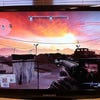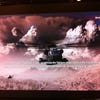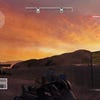Operation Flashpoint: Red River
Crimson tidings.
Holding down the right bumper brings up a radial menu with a host of options, allowing to you order your team to suppress targets, clear buildings or even provide overwatch support all within a couple of simple clicks. The d-pad allows you to select individual members of your fireteam or you can give a group command. It's simple and, once you've got to grips with the system, effective, and you come to feel a sense of responsibility and affection for your three compatriots that builds quickly through the campaign.
Part of the reason for this is that each mission is long and arduous, some taking up to an hour to complete. 60 minutes of concentrated effort and tension brings men together, even if they are virtual soldier men. So when you dive into the campaign with three real friends, playing co-operatively online, the result is mesmerising.
It's the kind of playpen designed to create personal memories: the time one of your friends took a miracle shot on a helicopter pilot and brought the bird down, or when you managed to retreat from the Chinese PLA against overwhelming odds without anyone losing a life. Some of these memories are scripted, but they often feel like your own. Find three competent friends to play through the game with and you will have one of the best shooter experiences currently available. No question.
The overarching design of the game has been tightened up since Dragon Rising, too. Now you earn experience points for making kills and completing objectives, levelling up your class of choice and, in doing so, gaining points that can be allocated to improve stamina, reload rates or the ability to pick out targets. Each mission is graded Bronze, Silver or Gold, with more class points won the better the medal.
Once the campaign is spent, a series of Fireteam Engagement missions are available to play through across four different types, asking you to defend fixed positions, rescue downed pilots, protect convoys or sweep an area to eliminate enemy forces, in a series of scored challenges complete with leaderboards.
It's not quite all good news. Animations are jumpy, with enemies occasionally shifting three paces to the right, or flicking between crouching and standing positions without grace. Lines of dialogue sometimes repeat, breaking the sense of authenticity that the game works so hard to create.
The vehicle sections aren't Codemasters' best work, and the engine in general, while excellent at huge draw distances, veers between beautiful and scrappy. This lack of polish only slightly detracts from the experience but while there is much less of the roughness that defined Red River's predecessor, it is noticeable nonetheless.
The game is also going to disappoint PC military sim veterans expecting a rival to ArmA II. This is more tactical shooter than true military sim, and the lack of a mission editor or CTI mode, together with the relatively prescribed mission orders, will no doubt grate.
While the AI is certainly improved from Dragon Rising, you'll still need to pay close attention not to direct teammates into dangerous situations as they'll follow orders without question and often pay the ultimate price for it. The removal of tight time limits removes much of the irritation of the first game but even so, players approaching Red River as a tactical shooter couched in an engaging story will get the most from it.
At its best, Red River surpasses Ubisoft's original Ghost Recons for squad-based tactical play. But it's the presentation of the story – not the broad-canvas story, but the story of four marines and their staff sergeant – that marks it out as something new. We still may be some way from the bite and nuance of Generation Kill, but in communicating the camaraderie, banter, fear and glory of modern warfare in the Middle East, nothing can touch this.




